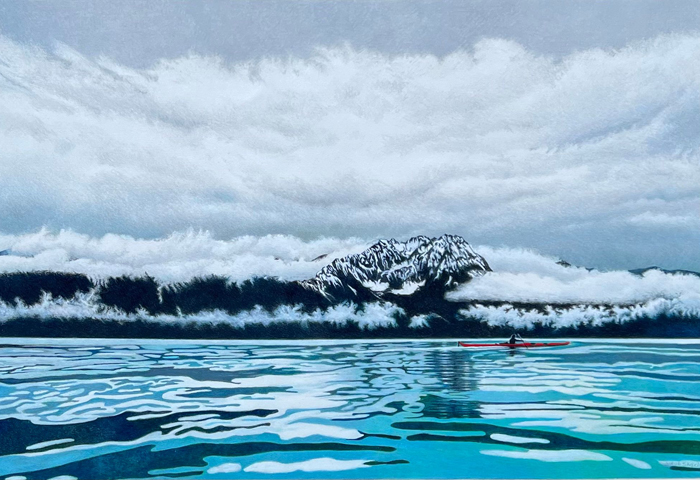In this series of works, Shepelak – a resident of Traverse City and Oak Park, Illinois – captures the dynamic, changing, and diverse faces of water as she has encountered it during travels locally and throughout the United States and Canada. Along the way, her expert use of colored pencils brings each of these scenes to vibrant, vigorous life.
“I enjoy watching the movement of water, and the way the sky and the surrounding landscape are reflected in the water,” Shepelak said. “I love the rippling sound and crashing waves, and I have experienced a bit of awe and fear when kayaking on a large open body of water.”
Pictured above: Kayaking On Resurrection Bay [Seward, Alaska]
A Few Points About Fine Art Drawing with Colored Pencils
Ancient Greeks and Egyptians used wax-based crayons, but the production of colored pencils for everyday art purposes didn’t start until the early 20th Century when a German based company called Faber-Castell introduced the first colored pencils designed specifically for artists.
There are many brands of colored pencils in both artist and student grades, and they come in three different types: wax based, oil based, and water soluble. Additionally, there are pastel pencils.
When drawing, to create a specific color tone it is not unusual to put down 10 -15 or more layers especially when creating deep tones. When blending colors, I begin with the lightest color and keep layering different colors over to create a specific tone or intensity.
Applying different pressures to the pencil also helps when creating tones. For example: press lightly for lighter tones, and heavier for darker ones. Using a burnisher tool helps blend color while adding depth. One can use odorless mineral spirits (a solvent) to blend colors and smooth them out. Once the surface dries, more color is added on top.
Generally, one puts down color in a consistent direction and then overlaps, and changes direction when adding the next layer of color. There are other techniques though: Some people crosshatch, and others use a circular motion. It is helpful to know that colored pencils are not completely opaque, and layers underneath will show through.
The paper one uses for colored pencil art varies: Smooth papers take less layers while textured papers hold many. Even though it will take a lot of layers to fill the tooth of a more textured surface, the depth of tone will be greater. I have gone as far as using sanded papers, which create a very soft feel once enough pencil gets down. When using sanded papers, some people will add a base color using pan pastels which helps fill the paper grain. Colored pencil is then added over the pan pastel.
The most important rule with colored pencils is to keep your pencils sharp. It may seem a simple tip but it’s important when building up colors and getting color into the paper grain.
– Judith Shepelak









